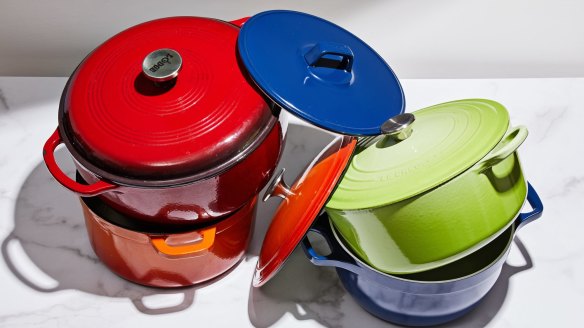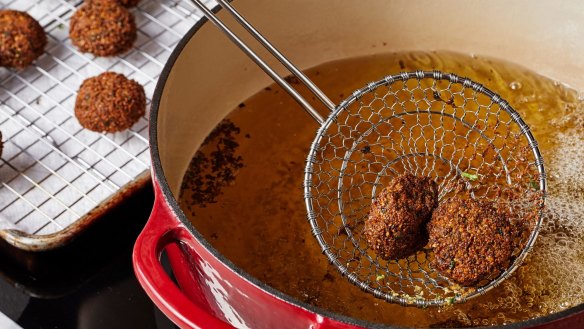Everything you need to know about Dutch ovens

One of the most common questions readers ask about cookware is something along the lines of "What can I do with my Dutch oven?"
I have a few theories about this. One: Dutch ovens of a certain cachet, namely Le Creuset, are typical gifts or big-splurge investments, and no one wants to mess up a beautiful, pricey piece. Two: Home cooks are faced with indecision once they realise a more apt question might be "What can't I do in my Dutch oven?"
"I love them," says cookbook author Molly Stevens, who knows a thing or two about Dutch ovens as the owner of seven. (Her new book, All About Dinner, calls for one in a few recipes.) "They are just so bulletproof and so reliable."
Whether you've already acquired a Dutch oven, or are considering acquiring one (or, um, six more), here's what you need to know about choosing and using them.
What are Dutch ovens
French manufacturer Le Creuset has done a lot of research into the origins of the Dutch oven, but it's difficult to pinpoint one specific time or person, says Nate Collier, the company's director of marketing communications and culinary. Its current form - a large, heavy pot with a tight-fitting lid - probably arose from the need to cook outdoors over coals or in an indoor hearth. As to the name? Collier says one theory involves an English manufacturer who went to the Netherlands, saw the process in which the pot was cast and so named it Dutch. Today, most recipes work under the assumption that a Dutch oven is made of cast iron, enamelled or uncoated, although you can find stainless steel and ceramic models, as well.
As great as they are as cookers, Dutch ovens are also lookers, meaning they can double as beautiful serving pieces and even kitchen decor.
Why you should consider buying one
There are a variety of reasons to add a Dutch oven to your kitchen arsenal. I love that it can be used on the stove top and in the oven. Its tight fitting lid sets up a constant, convective flow of moisture and air in a sealed environment, which would be impossible to replicate with an uncovered dish in a standard oven. It has all the advantages of cast iron, Collier says, namely an ability to retain a steady heat at high and low temperatures, ideal for, respectively, searing as well as slow, gentle cooking. If you go with an enamelled Dutch oven, you also get the benefit of food that is easier to release and a surface that's simpler to maintain. As great as they are as cookers, Dutch ovens are also lookers, meaning they can double as beautiful serving pieces and even kitchen decor.
How to pick one

One of a Dutch oven's signature traits is its heft. That should be a key consideration, says Stevens, especially if you struggle to lift heavy objects or will have to bend or lift a lot to get the pot in and out of the oven. In America's Test Kitchen's equipment test of large Dutch ovens, the heaviest model clocked in at more than 8 kilograms with the lid. If you can, check out models in the store so you can gauge the weight, as well as how easy it is to grip and manoeuvre the lid and handles, particularly when you're wearing oven mitts.
The rigorous ATK equipment testers suggest that thicker pots are better, as thinner ones can run hot and scorch food. Lighter-colored surfaces, such as enamel, a type of glass, let you monitor browning better. You want plenty of surface area for browning in as few batches as possible, so consider a wider, shorter pot rather than a taller, narrower one. Taller pots can be tricky to fit into the oven or your refrigerator, and even if you succeed, you may need to rearrange your racks or shelves.
ATK says oval Dutch ovens are just as effective as round ones, as long as you give them sufficient time to preheat. Keep in mind that ovals might limit what else you can fit on your stove top on adjacent burners. As far as size, Stevens says a five-litre model is a great starter, and close to a decade into owning one of those, I have seldom found myself limited by the smaller size.
Price is, of course, another consideration. At typically hundreds of dollars, a larger Le Creuset is not cheap. But, given that these pieces can last for generations, the investment might be easier to swallow. Collier says those looking to save should visit one of the brand's outlet locations, stay abreast of its pop-up factory stores or be ready to pounce on promotions on discontinued or overstocked colours during the holidays. That being said, other established brands churn out more affordable Dutch ovens, too.
Care and tips
Enamelled cast iron can hold up to a lot, but you do need to keep a few things in mind. Like glass such as Pyrex, enamel can be subject to thermal shock when exposed to dramatic temperature changes. That's why you should never heat an empty enamelled Dutch oven on the stove top, although Collier confirms it's perfectly safe to preheat it in the oven with a gradual increase in temperature, as you do for something like bread. Generally, you also want to stay away from using high heat, except for boiling. Even then, you'll likely want to turn down the heat eventually, as the cast iron's efficiency could lead to a boil-over.
If you're using your Dutch oven in the regular oven, be sure your lid and knob are oven-safe. If the knob is not, such as the black ones on some older Le Creusets, or you're not sure, remove the knob temporarily or buy one that is.
Stevens says she prefers to use wooden utensils to protect the enamel. If you're scraping up fond (flavourful browning on the bottom of the pot), definitely stick with wood, nylon or silicone. You can, however, safely use metal utensils, especially for serving, Collier says. You may see marks left behind on the enamel, but it's cosmetic. Cleaners such as Bar Keepers Friend can help restore the surface. Do not bang metal utensils on the side of the Dutch oven, or you risk chipping the enamel. Still, an inadvertent chip or two is not the end of the world and will not render the pot unusable.
Soap and water can handle most of your routine cleaning. An abrasive such as Bar Keepers Friend can help remove caked-on food and some stains. If you're really disconcerted by discolouring, ATK has found success with an overnight soak with a 3-to-1 solution of water and bleach, which it says was approved by Le Creuset.
Obvious ways to use it
Stevens has written the definitive tome on braising, so, naturally, that's one of her favourite ways to cook in a Dutch oven. The constant exchange of moisture and flavours means you can get amazingly tender and tasty meat, whether it's pot roast, short ribs or chicken. That's the kind of situation that also lends itself to something like overnight baked beans.
Of course, soups, chilis and stews are a given. You might as well make a bread to go with them, right? I can't recommend Dutch oven bread enough, either, as you get a superb crust, thanks to the heat of the cast iron and the steam trapped inside of it.
Also don't be afraid to use your Dutch oven as what it is: a pot. Mine is my go-to for boiling pasta and making broth. Stevens uses a little one for making rice. They're not too precious to use on an everyday basis. Promise.
Less obvious ways to use it
Dutch ovens are great for frying, shallow or deep. High sides reduce concerns about splattering, and that heat retention I've been hammering home means it's easier to manage the temperature of the oil. Plus, it reduces the time you need to wait in between batches. So you go ahead and make that fried chicken! Or falafel!
ATK offers a number of clever ideas, including roasting a side of vegetables on the overturned lid of a Dutch oven while your main course braises below. Collier says Le Creuset partnered with ATK on an especially smart recipe for a pot pie in which the filling is cooked in the Dutch oven while the crust bakes on the inverted lid, allowing it to remain crisp. Then the crust is slid onto the filling.
Keep in mind that a Dutch oven's ability to maintain a steady temperature is just as applicable when that temperature is cold. If you're serving a chilled or composed salad, Collier recommends using a Dutch oven as a serving vessel. Pop it in the fridge or freezer, or fill it with ice water first.
The Washington Post
- More:
- Food
- Home and design